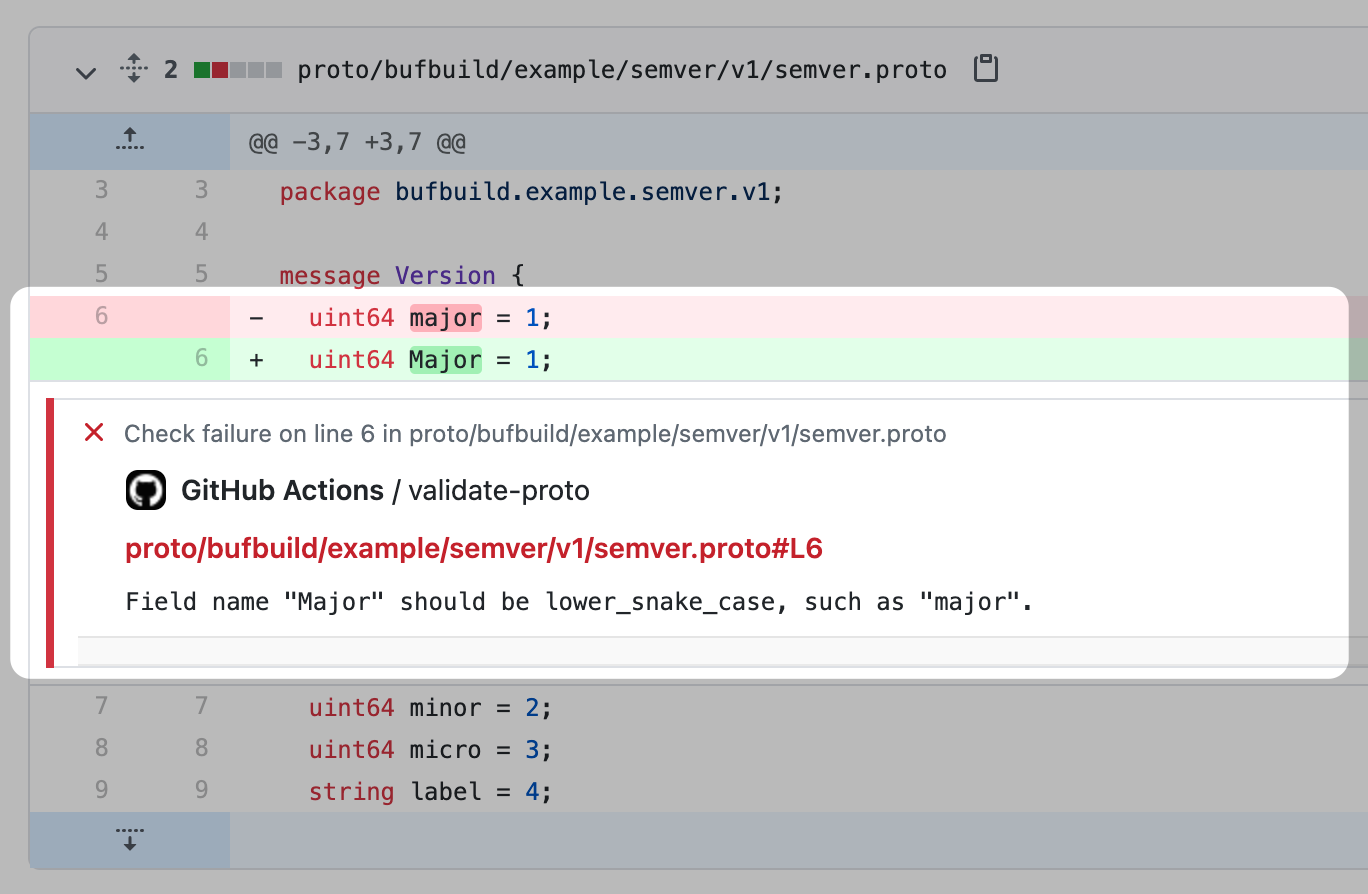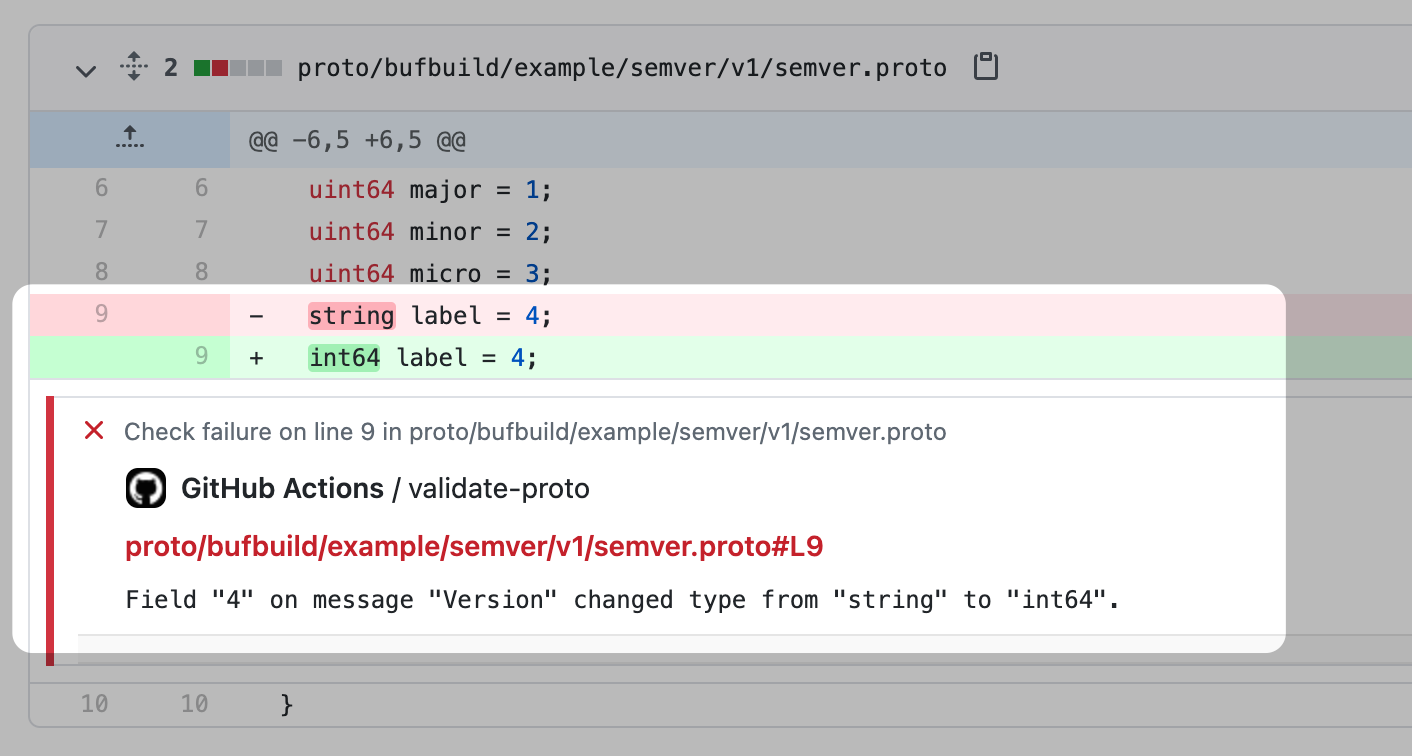GitHub Actions for Buf now available
Note. This post was originally published in April 2021 and has been updated for accuracy based on recent improvements.
Buf officially supports a collection of GitHub Actions to instrument your CI/CD Protocol Buffers workflows with the buf CLI. This guide will walk you through the steps required to create a GitHub workflow that runs buf-setup, buf-lint, buf-breaking, and buf-push.
TL;DR
- The buf-setup action installs
buffor use in other custom actions that require thebufCLI. - The buf-lint and buf-breaking actions ensure that your Protocol Buffers API changes always conform to your
lintandbreakingconfigurations. Lint failures and breaking changes are written as annotations to GitHub Action runs and in-line comments on PRs. - The buf-push action automatically keeps your GitHub repository in-sync with the Buf Scheme Registry (BSR).
- Write your workflow configuration once and consistently across projects, and leave the rest to
buf.
Quick Start
Here's a full example to get you started with lint and breaking changes on pull requests.
The only prerequisite is the commands buf lint and buf breaking are executable from the root of the directory that contains your Protocol Buffers definitions. In most cases you'll want to define a buf.yaml configuration file to tailor buf to your project.
Create a .github/workflows/buf-pull-request.yaml file:
name: buf-pull-request
on: pull_request
jobs:
validate-proto:
runs-on: ubuntu-latest
steps:
- uses: actions/checkout@v2
# Install and setup buf (default latest version)
- uses: bufbuild/buf-setup-action@v0.3.1
# Lint
- uses: bufbuild/buf-lint-action@v0.3.0
# Breaking change detection
- uses: bufbuild/buf-breaking-action@v0.4.0
with:
# The 'main' branch of the GitHub repository that defines the module
against: "https://github.com/${GITHUB_REPOSITORY}.git#branch=main"
Let's break it down:
buf-setup-actioninstalls thebufCLI, making it available for all subsequent steps within the job.buf-lint-actionverifies your Protocol Buffers files conform to lint rules.buf-breaking-actionchecks for backwards-incompatible changes.
As mentioned, a buf.yaml configuration file can be added to customize buf for your project. Below is an example to get your started:
version: v1
lint:
use:
- DEFAULT
breaking:
use:
- FILE
Lint
For more in-depth information on lint and specific lint rules, refer to the Lint documentation. Here we'll showcase a lint violation with buf-lint, extending the quick start example above.
Suppose we have this .proto file that defines a Version message:
syntax = "proto3";
package bufbuild.semver.v1;
message Version {
uint64 major = 1;
uint64 minor = 2;
uint64 micro = 3;
string label = 4;
}
A developer mistakenly updates the major field to Major, such that it violates the lint configuration. To be more specific, this change doesn't conform to the FIELD_LOWER_SNAKE_CASE rule.
message Version {
- uint64 major = 1;
+ uint64 Major = 1;
uint64 minor = 2;
uint64 micro = 3;
string label = 4;
}
The buf-lint action will detect this change and fail the step. Furthermore, it'll add annotations to the GitHub Action run and comment in-line on the PR. Enabling developers to quickly fix their mistakes and keep iterating.

Breaking changes
For more in-depth information on breaking changes, refer to the Breaking documentation. Here we'll showcase a breaking change with buf-breaking, extending the quick-start and lint examples above.
In this example we're running breaking change detection against the HEAD of our main branch. The developer fixed up the lint error from the example above, but has decided to change the type of the label field.
message Version {
uint64 major = 1;
uint64 minor = 2;
uint64 micro = 3;
- string label = 4;
+ int64 label = 4;
}
The buf-breaking action will detect this change and fail the step. Similar to lint, the action will add annotations to the GitHub Action run and comment in-line on the PR.

Push to BSR
The Buf Schema Registry (BSR) is a platform that serves as a source of truth for your Protocol Buffers files.
Once you've setup lint rules and breaking change detection a natural next step is to synchronize your Protocol Buffers files with the BSR. Building on the example above, you can adapt this workflow so that commits merged into the main branch will automatically push Protocol Buffers file updates to the BSR.
This might be a good time to read about Modules. A collection of Protocol Buffers files that are configured, built, and versioned as a logical unit.
To write to the BSR you'll need an API token. For details on creating a token click here. Once you've created a token you'll want to store it as an encrypted GitHub Secret. In this example we'll refer to this token as BUF_TOKEN.
Note, in the examples above the GitHub workflow was configured to run on every pull_request event. We do not, however, want to push to the BSR on every pull request commit. Let's create a separate workflow file .github/workflows/push.yaml that performs a similar workflow, but triggered on pushes to the main
branch.
name: buf-push
on:
push:
branches:
- main
jobs:
push-proto:
runs-on: ubuntu-latest
steps:
- uses: actions/checkout@v2
- uses: bufbuild/buf-setup-action@v0.3.1
- uses: bufbuild/buf-lint-action@v0.3.0
- uses: bufbuild/buf-breaking-action@v0.4.0
with:
against: "https://github.com/${GITHUB_REPOSITORY}.git#ref=HEAD~1"
- uses: bufbuild/buf-push-action@v0.3.0
with:
buf_token: ${{ secrets.BUF_TOKEN }}
This workflow is running lint and breaking change detection against the prior commit on the current branch, this is why we added #ref=HEAD~1. Once those steps have succeeded the buf-push-action will push the module (Protocol Buffers files) to the BSR. The module on the BSR is tagged with the git commit SHA so there is a direct link between your GitHub repository and the BSR.
Note, ref=HEAD~1 does not work well for rebase and merge operations, since buf is comparing against the last commit there might be older commits with breaking changes. If you're using Merge pull request (GitHub default) or Squash and merge options then #ref=HEAD~1 will work.
Inputs
Projects adopting buf will have different layouts and configurations. All of our GitHub Actions are meant to be configurable depending on your needs.
If your directory structure doesn't match the examples above you may need to explicitly set an input field and a subdirectory via subdir in your GitHub actions, for more information see the Inputs documentation.
Wrapping up
Now that you have all of the Buf GitHub Actions configured in your CI/CD pipeline, you'll never have to worry about manual Protocol Buffers maintenance again. If you have any questions or feedback, please reach out in our public Slack channel!